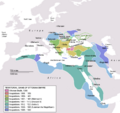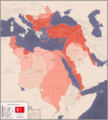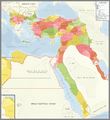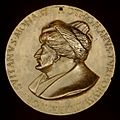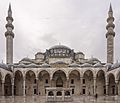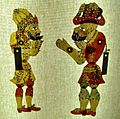Ottoman Empire facts for kids
Quick facts for kids
The Sublime Ottoman State
Ottoman Empire
Osmanlı İmparatorluğu دولت عالیه عثمانیه Devlet-i Âliye-yi Osmâniyye |
|||||||||
|---|---|---|---|---|---|---|---|---|---|
| 1299–1923 | |||||||||
|
'Motto: 'دولت ابد مدت
Devlet-i Ebed-müddet ("The Eternal State") |
|||||||||
|
Anthem: (various)
|
|||||||||

Ottoman Empire at its peak in 1683.
|
|||||||||
| Status | Empire | ||||||||
| Capital | Söğüt (1299–1326) Bursa (1326–1365) Edirne (1365–1453) Constantinople (1453–1922) |
||||||||
| Government | Monarchy | ||||||||
| Sultans | |||||||||
|
• 1281–1326 (first)
|
Osman I | ||||||||
|
• 1918–22 (last)
|
Mehmed VI | ||||||||
| Grand Viziers | |||||||||
|
• 1320–31 (first)
|
Alaeddin Pasha | ||||||||
|
• 1920–22 (last)
|
Ahmed Tevfik Pasha | ||||||||
| History | |||||||||
|
• Founded
|
1299 | ||||||||
| 1402–1413 | |||||||||
| 1876-1878 | |||||||||
|
• 2. Constitutional
|
1908-1918 | ||||||||
|
• Succeeded
|
July 24 1923 | ||||||||
| Area | |||||||||
| 1680 | 5,500,000 km2 (2,100,000 sq mi) | ||||||||
| Population | |||||||||
|
• 1856
|
35350000 | ||||||||
|
• 1906
|
20884000 | ||||||||
|
• 1914
|
18520000 | ||||||||
|
• 1919
|
14629000 | ||||||||
| Currency | Akçe, Kuruş, Lira | ||||||||
|
|||||||||
| Today part of | |||||||||
The Ottoman Empire was a powerful empire that lasted for over 600 years. It began in 1299 and ended in 1923. The empire was centered in what is now Turkey. It grew to control lands around the Mediterranean Sea, including parts of southeastern Europe, southwest Asia, and northern Africa.
Osman I founded the empire around 1299. It became very strong between 1400 and 1600. During this time, it played a major role in trade and politics. One of its most famous and powerful rulers was Suleiman the Magnificent.
The Ottoman Empire was made up of many different lands and peoples. The Sultan, who was the ruler, sent governors to manage these areas. These governors had titles like Pasha or Bey. The empire also had "tributary states." These were countries that kept some independence but paid money or tribute to the Sultan.
Over time, the Ottoman Empire started to become weaker. By the late 1800s, people sometimes called it "the sick man of Europe." The empire was on the losing side in World War I and eventually broke apart.
Contents
History of the Ottoman Empire
Founding and Early Growth (1299-1453)
The Ottoman Empire was started by Osman I in 1299. His son, Orhan, captured Bursa, which became the first capital. This was taken from the Byzantine Empire. In the late 1300s, the Ottomans grew stronger, especially in the Balkans.
Sultan Murad I defeated Serbia in 1389 at the Battle of Kosovo. Murad died in this battle, and Bayezid I became the new Sultan. In 1396, the Ottomans won a big victory against European crusaders at the Battle of Nicopolis.
However, Bayezid was defeated by Tamerlane at the Battle of Ankara in 1402. This led to a civil war called the Ottoman interregnum. Mehmed I won the war and became Sultan. His son, Murad II, fought against rivals supported by the Byzantine Empire. Murad II expanded the empire and defeated armies from Hungary and Poland at Varna in 1444.
Peak of Power and Expansion (1453-1566)
Mehmed the Conqueror captured Constantinople on May 29, 1453. This was a huge victory and made Constantinople the new capital. He also allowed more freedom for the Orthodox Church. Mehmed and his son, Bayezid II, continued to expand the empire.
Selim I conquered Egypt and the Levant from the Mamluks in 1517. He also defeated the Safavid Persians in 1514. The Ottomans also had conflicts with Portugal over trade routes.
Suleiman the Magnificent, Selim's son, captured Belgrade and much of Hungary after the Battle of Mohács in 1526. His attempt to capture Vienna in 1529 was stopped. Countries like Transylvania, Wallachia, and Moldavia became states that paid tribute to the Ottomans.
In the east, the Ottomans took Baghdad from the Safavids. Suleiman also made an alliance with Francis I of France against the Habsburgs. This led to Ottoman control in the Mediterranean, capturing places like Rhodes and Tunis. Many historians believe that the empire began to slow down after Suleiman's death in 1566.
Challenges and Decline (1566-1800s)
The Ottomans lost a major naval battle at Lepanto in 1571 to a European alliance. While they quickly recovered and captured Cyprus, this defeat showed that the Ottomans were not unbeatable.
The empire faced many challenges in the following years. They had a long war with Austria that ended in a stalemate. The Safavids also attacked their eastern lands. During this time, some powerful women in the Sultan's family, like Kösem Sultan, gained more influence. The Grand Vizier, a top minister, also became more important.
The Ottomans captured Crete and parts of southern Ukraine. However, a Grand Vizier named Kara Mustafa Pasha made a mistake by attacking Vienna again. This led to the Great Turkish War, where Austria, Poland, Russia, and Venice attacked the Ottomans. The Ottomans lost much land in this war, including Hungary and parts of Greece.
Russia and the Ottomans fought several wars. Russia took over Crimea in 1783. They also claimed to protect Orthodox Christians in the Ottoman Empire. Sultan Selim III tried to modernize the military, but the Janissary corps, elite soldiers, revolted. Napoleon also attacked Egypt but was driven back by the British.
Reforms and Final Collapse (1800s-1923)
In the 1800s, the Ottoman Empire tried to reform itself. This period was called the Tanzimat. Reforms included new military training, a central bank, and changes to laws. However, the empire continued to struggle. European countries began to control the empire's finances due to its large debts.
The Ottomans lost more territories. Serbia gained some independence in 1815, and Greece won full independence after a long war from 1821 to 1829. Muhammad Ali Pasha of Egypt almost captured Constantinople.
The empire was called the "sick man of Europe" because of its weakness. In 1878, after another war with Russia, Romania, Serbia, and Montenegro became fully independent. The British took Cyprus and Egypt.
In 1908, a group called the Young Turks led a revolution. This led to a new Sultan, Mehmed V, and attempts at more reforms. However, the empire continued to shrink. In 1912, they lost Libya to Italy. The Balkan Wars (1912-1913) caused the Ottomans to lose almost all their European lands.
In 1914, the Ottoman Empire joined World War I on the side of Germany and Austria-Hungary. They fought against Russia, Britain, and France. The Ottomans won some early battles, like the Battle of Gallipoli.
However, the war brought terrible events. In 1915, the Armenian Genocide began. This was a mass killing of Armenians, Assyrians, Greeks, and other groups. Millions of people died. The empire also faced the Arab Revolt in 1916, supported by the British.
The Ottoman Empire eventually lost the war and surrendered in 1918. The Turkish War of Independence followed, led by Mustafa Kemal Atatürk. This war was fought against the old Sultan's government and invading European powers. The Turkish national movement won, and the Republic of Turkey was founded. In 1923, the Ottoman Empire officially came to an end.
Sultan's Family and Rule
The Ottoman Empire was a hereditary monarchy. This means the ruler's title, 'Sultan', was passed down through the family. In the early years, the Sultan's sons, called shahzadahs, were sent to different parts of the empire. This was to give them experience in governing. They would then be considered to become the next Sultan.
Later, this system changed. A new Sultan would sometimes keep his male relatives locked away. They lived in a small apartment called a kafes and could not see the outside world. This was to prevent them from trying to take power. Sometimes, a new Sultan would even have his male relatives killed to remove any competition.
The women in the Sultan's harem often tried to gain more power. The Sultan's mother could become a very important political figure. Each mother in the harem wanted her own son to become the next Sultan. This was because if her son did not become Sultan, he might be killed.
Over time, the Sultans found it harder to control faraway lands. Distant governors often made their own rules instead of following the Sultan's orders. By its end, the Ottoman Empire became very weak and corrupt.
Capital Cities
Bursa was the first capital of the Ottoman Empire. Later, Edirne in Thrace became the capital in 1365. Finally, after its conquest by the Turks, Istanbul (formerly Constantinople) became the empire's last and most famous capital.
Vassal States
Many areas were "vassal states" to the Ottoman Empire. This meant they were not directly ruled by the Sultan. Instead, they had some independence and self-rule. These included Transylvania, Moldavia, and Wallachia (which later became Romania). Parts of the Caucasus, like Georgia, Dagestan, and Chechnya, were also vassal states.
The rulers of these vassal states had a degree of autonomy. In return for this freedom, they paid money or "tribute" to the Sultan.
Images for kids
-
The Battle of Nicopolis in 1396, shown in an Ottoman miniature from 1523.
-
Sultan Mehmed the Conqueror entering Constantinople; painting by Fausto Zonaro.
-
An Ottoman miniature of the Battle of Mohács in 1526.
-
The Second Siege of Vienna in 1683, by Frans Geffels.
-
Austrian troops led by Prince Eugene of Savoy captured Belgrade in 1717.
-
Selim III meeting important people at the Topkapı Palace. Painting by Konstantin Kapıdağlı.
-
The siege of the Acropolis in 1826–1827 during the Greek War of Independence.
-
Opening ceremony of the First Ottoman Parliament at the Dolmabahçe Palace in 1876.
-
Ottoman troops attacking Fort Shefketil during the Crimean War of 1853–1856.
-
Mehmed VI, the last Sultan of the Ottoman Empire, leaving the country in 1922.
-
A European bronze medal of Sultan Mehmed the Conqueror, 1481.
-
Smyrna under Ottoman rule in 1900.
-
Abdülmecid II was the last caliph of Islam and a member of the Ottoman dynasty.
-
Mehmed the Conqueror and Patriarch Gennadius II.
-
Süleymaniye Mosque in Istanbul, designed by Mimar Sinan in the 16th century.
-
Members of Beşiktaş J.K. in 1903.
-
A miniature showing the Mehteran, the music band of the Janissaries.
See also
 In Spanish: Imperio otomano para niños
In Spanish: Imperio otomano para niños







